Our National Marine Sanctuaries: A Legacy of Protecting America’s Oceans and Coasts
The NOAA National Marine Sanctuary Program manages a national network of underwater marine protected areas. Designated by Congress, these special ocean and Great Lakes areas are designed to protect natural and cultural resources while allowing people to use and enjoy our oceans and coasts. The first sanctuary was created in 1975 and the network has since grown to include 13 national marine sanctuaries and one marine national monument.
- Introduction
- Growing Environmental Movement
- Birth of the Sanctuary Program
- Getting Started
- Network Continues to Grow
- Conclusion
- Works Consulted
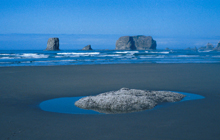
Offshore rocks provide nesting and roosting habitat for birds. These remote rock islets are part of Quileute Needles National Wildlife Refuge, created in 1908 to protect seabird habitat. Three national wildlife refuges lie within Olympic Coast National Marine Sanctuary. Click image for larger view and image credit.
Earth Day 1970 officially marked the beginning of the modern environmental movement, highlighting growing concerns about human impacts on the Earth's ecosystems, including oceans and coasts. In response to concerns from the scientific community and the public, Congress began creating legislation to help us manage our nation's oceans, coastal regions, and Great Lakes. One of these bills, the Marine Protection, Research, and Sanctuaries Act, created a legal framework for establishing a national network of marine sanctuaries, patterned after our national park system and to be administered by NOAA.
This article traces the early history of NOAA's involvement in the creation and management of the National Marine Sanctuary System.
The Growing Environmental Movement
The NOAA National Marine Sanctuary Program traces its roots back to the early 1960s and the burgeoning environmental movement led by prominent figures like filmmaker Jacques Cousteau and writer Rachel Carson. Cousteau's work in particular underscored the precarious state of the world's oceans. As the impact of pollution on the environment gained more widespread attention in the media, elected officials, and the general public began to take notice.
Legislation soon emerged in the U.S. Congress with the purpose of improving the nation's ocean management. The Marine Resources and Engineering Development Act of 1966 created the influential Stratton Commission on Marine Sciences, Engineering, and Resources.
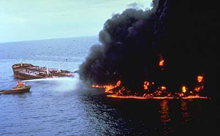
Oil spills often heighten public concern for the environment. The Mega Borg released 5.1 million gallons of oil as the result of a lightering accident and subsequent fire. The incident occurred 60 nautical miles south-southeast of Galveston, Texas on June 8, 1990.
In 1969, the Stratton Commission released a report entitled Our Nation and the Sea: A Plan for National Action, which stressed the ocean as a frontier for resource development, emerging threats to the coastal environment, and the need to coordinate federal ocean and coastal management programs. The Commission also made recommendations to establish an independent agency to manage federal civil marine programs and a national coastal management program.
That same year, an oil well ruptured off the coast of Santa Barbara and coated some 30 miles of California's coastline with over 235,000 gallons of crude oil in what would become one of the worst environmental disasters in the country's history. The spill received national media coverage and galvanized public opinion in favor of stronger environmental protections.
In response to recommendations by the Stratton Commission and growing public concern for the health of our nation's oceans and coasts, NOAA was created in 1970 as the nation's marine management agency.
The Birth of the Sanctuary Program
Efforts to improve federal marine management did not end with the foundation of NOAA—in fact, they were just beginning. In response to continued pressure from the public, Members of Congress began to lend their support to legislation that called for specific protection of particularly valuable areas of the nation’s oceans, coastal regions, and Great Lakes.
In 1970, just a few months after the creation of NOAA, legislators introduced a bill to create a national network of ‘marine sanctuaries’ patterned after the Wilderness Act and its National Park System. After two years of deliberation, President Richard Nixon signed the Marine Protection, Research, and Sanctuaries Act into law on October 23, 1972, and the National Marine Sanctuary Program was born.
The fledgling sanctuary program was charged with identifying and designating as national marine sanctuaries areas of “special national significance.”
The goals set for the sanctuaries included protecting and maintaining the environment and wildlife communities; educating the public about marine conservation and the ocean’s natural, cultural, and historical resources; promoting and coordinating scientific research; and facilitating compatible commercial and recreational activities within the sanctuaries.
Establishing a System of Marine Sanctuaries: Getting Started
Now that Congress had granted the federal government authority to establish sanctuaries, a significant question remained: which areas should it establish?
The first answer came a year later, in 1973, when researchers discovered the wreckage of the Civil War ironclad USS Monitor off the coast of North Carolina. Two years later, in 1975, the site of the Monitor wreck became the first national marine sanctuary. Later that same year, President Gerald Ford designated the Key Largo National Marine Sanctuary in Florida.
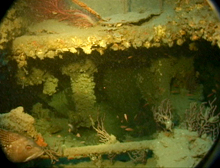
The first national marine sanctuary protected the site of the wreck of the Civil War ship the USS Monitor. This image shows the port-side view of the Monitor's vibrating side lever engine under the engine frames and platform. Click image for larger view.
In 1979, President Jimmy Carter began to use the Sanctuaries Act to its full potential. Under his tenure, President Carter spearheaded the designation of four more sanctuaries. The Channel Islands (California) were designated in 1980 and the Gulf of the Farallones (California), Gray’s Reef (Georgia), and Looe Key (Florida) were designated in 1981.
President Carter also requested that NOAA create a list of recommended areas for designation as marine sanctuaries. Following this request, NOAA released a report in 1983 that evaluated a field of 67 candidate sites, which ranged in location from Alaska to the Caribbean Sea. Several places in the report would eventually be designated as sanctuaries, although most sites took ten years or more to establish.
Only two more sanctuaries were designated in the 1980s: American Samoa’s Fagatele Bay in 1986 and Cordell Bank, off the coast of California, in 1989.
The Network Continues to Grow
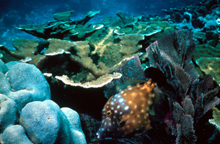
The designation of the Florida Keys National Marine Sanctuary by Congress in 1990 was prompted by a series of cumulative events of environmental degradation, the threat of oil drilling, and vessel groundings. Today, more than 2.5 million people visit the Keys each year, and of those, 70 percent visit the waters of the Sanctuary to fish, dive, and boat. Click image for larger view, full caption, and image credit.
With the start of the new decade, the sanctuary program entered a period of new growth, beginning with the designation of Florida Keys National Marine Sanctuary by Congress in 1990. The establishment of the Keys sanctuary, which incorporated Key Largo and Looe Key sanctuaries, served as catalyst for Congress to take a more active role in the creation of new sanctuaries. Three sites followed in 1992, with Congress designating Stellwagen Bank National Marine Sanctuary (Massachusetts), Hawaiian Islands Humpback Whale National Marine Sanctuary, and Monterey Bay National Marine Sanctuary (California) - the largest sanctuary in the system.
The establishment of these three sites focused attention on the fact that the sanctuary program needed increased funding to properly manage the 11 sites that now made up the National Marine Sanctuary System and to fully implement its science, education, and resource protection objectives. The sanctuary program's funding continued throughout the 1990s, as sanctuaries were recognized for playing an important role in protecting the nation's natural and cultural heritage and supporting the economic health of coastal communities.
Conclusion
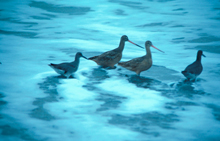
Shorebirds, like Marbled Godwits and Willets, race in the waves of Sanctuary beaches, probing the sand with their long beaks in search of food. Click image for larger view and image credit.
Today, the National Marine Sanctuary system includes 14 underwater marine protected areas: 13 national marine sanctuaries and one national monument. These national marine sanctuaries embrace part of our collective riches as a nation. Within their protected waters, giant humpback whales breed, temperate reefs flourish, and shipwrecks tell stories of our maritime history. Ranging in size from less than one square mile to 137,792 square miles, each sanctuary site is a unique place needing special protection.
Since its beginnings in 1972, NOAA’s National Marine Sanctuary Program has worked to manage and protect these specially designated areas of the nation’s oceans and Great Lakes.
Works Consulted
Chandler, W. J. & Gillelan, H. (2004). The History and Evolution of the National Marine Sanctuaries Act. [Electronic version] Environmental Law Reporter: News & Analysis 34 (June 2004): 10505-10565. Environmental Law Institute. Washington, DC.
Kennedy, J. F. (1961). September 25, 1961 Address before the General Assembly of the United Nations. United Nations, New York.
